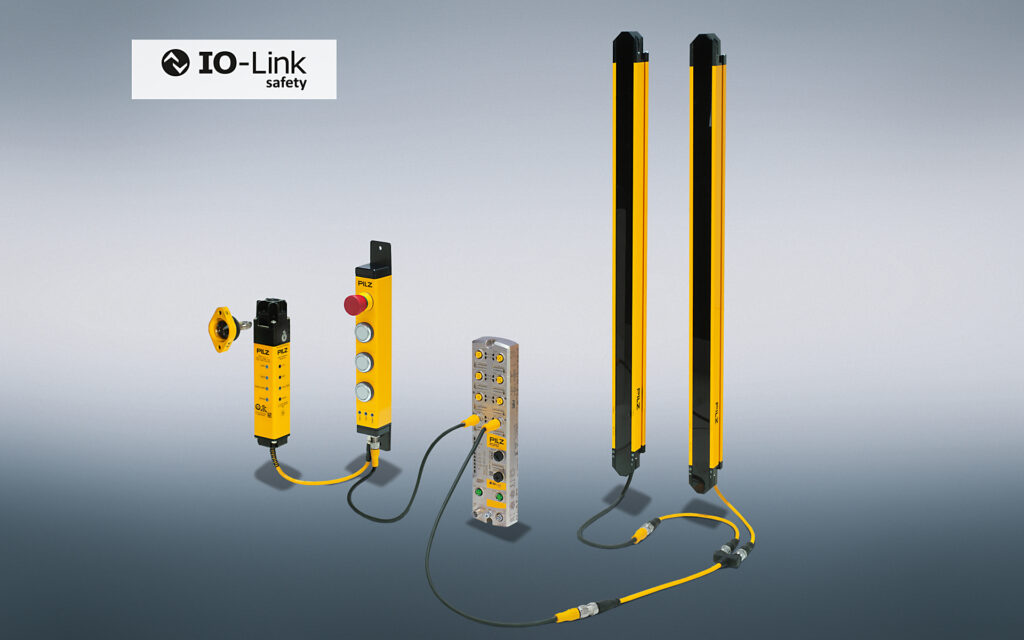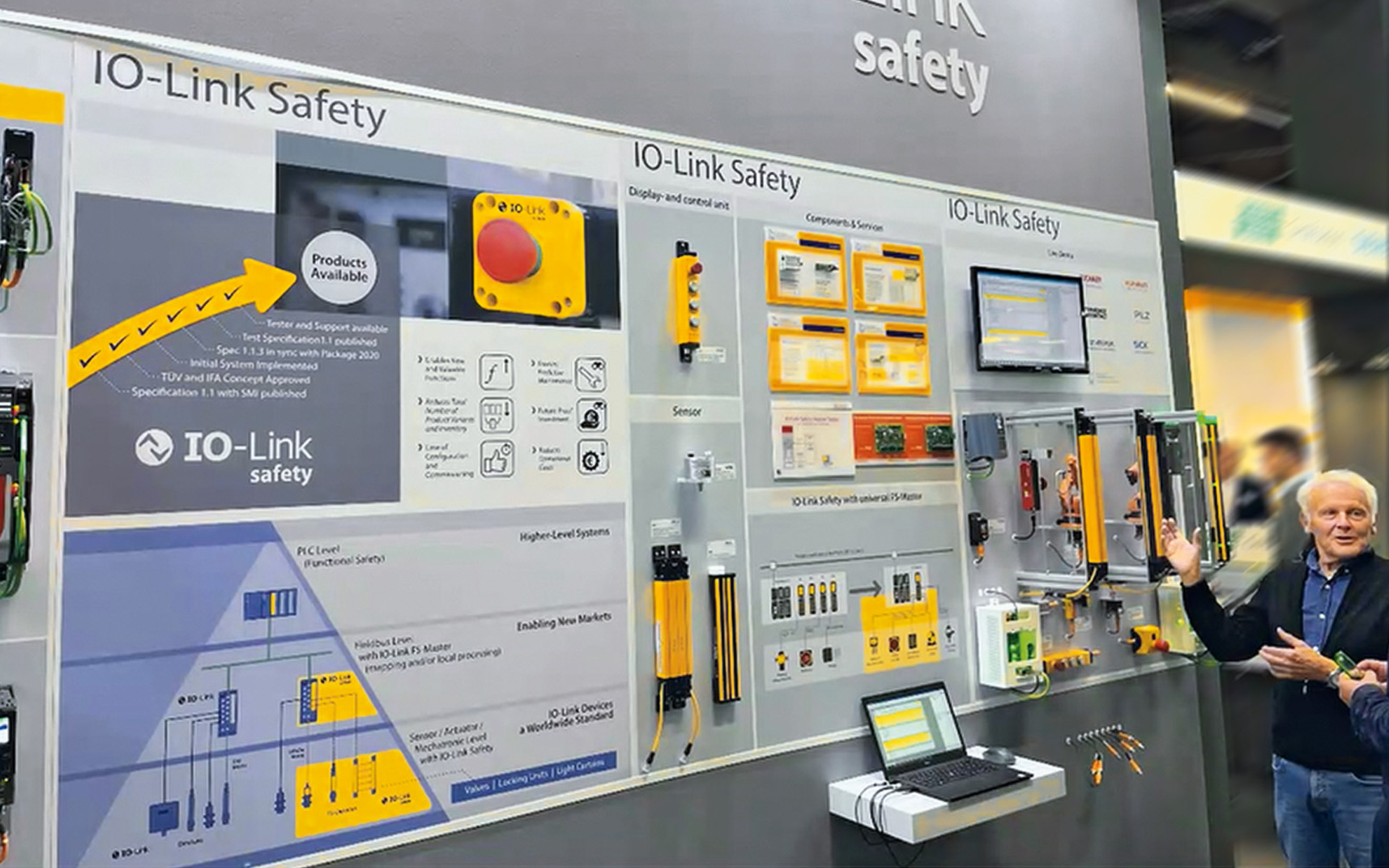Industrial communication – particularly at field level – must be able to provide safe data transfer up to the “last” sensor, and “can” additionally offer more availability and more flexible automation. Then production processes can be optimised.
The wish here: Safe data communication as well as fast installation and also the smallest possible warehouse space. The solution: Complete IO-Link Safety systems with master, sensors, field devices and configuration tool. Pilz is the first provider to offer this type of complete package – suitable in many respects, i.e. for a wide range of applications in a wide range of industries.
The master as an efficient director at field level
The IO-Link Safety master is used decentralised at field level, which reduces the cable length and already saves considerable space. Thanks to the point-to-point communication, wiring of the safety sensors is also much easier to implement. At the same time, the system can be used flexibly as conventional safety sensors, IO-Link Safety sensors and IO-Link devices can all be connected. And because communication generally occurs via unshielded cables and IO-Link Safety uses industry-standard connections, fewer cables are needed. Installation and replacing devices are thus challenges of the past: In truly less than a minute, connection of a standard M12 connector is possible; with conventional wiring this would be expected to take over an hour.

Bad time? Good time!
The connections are also less prone to wiring errors, and because the IO-Link Safety technology simultaneously provides the data for diagnostics, it is possible to immediately detect if a device was connected to the wrong port and the error can be rectified. Another advantage of this communication technology is that all devices in the interlinked plant are uniquely identified and parametrised.
The safe communication protocol IO-Link Safety thereby significantly improves the installation, commissioning and maintenance times, in that it reduces the times required for these. Downtimes, e.g. for necessary repairs, can be shortened considerably and maintenance can be proactively planned.
IO-Link Safety – Good to know:
What is point-to-point communication?
Point-to-point communication in information and communication technology (ICT) is a direct, immediate connection between two points or places. In terms of IO-Link Safety, this means that the field devices are directly connected to the decentralized IO-Link Safety Master via a simple 3‑wire, unshielded cable.
Which devices can be connected to the IO-Link Safety Master?
The Pilz IO-Link Safety Master PDP67 PN 8FDIO 4IOLS not only enables the connection of IO-Link Safety Devices. Classic safety sensors, IO-Link sensors and standard sensors and actuators can also be connected.
What does two-way communication mean?
Two-way communication means that information between two points can flow in either direction. This can be both cyclical and acyclic data.
First practical case: Interlinked plants
One or two glimpses of practical application show how IO-Link Safety can provide added value: for example in an interlinked packaging plant where several sensors are frequently used. These need space, especially for wiring, and involve a high overall installation effort. Sensors can be connected at a total of eight ports of the IO-Link Safety master from Pilz. At four IOLS ports, both IOLS safety sensors and IO-Link standard sensors can be connected.

To ensure redundancy of the safety, dual-channel connection options are essential: With so-called FDIO ports (Failsafe Digital Input Output), the user can choose between a safe input or a safe output and whether this should be dual-channel. Classic safety sensors such as safety switches, gate locking devices or emergency stop devices, etc. can thus be connected. OSSD (Output Signal Switching Device) signals can also be processed with this system. The Pilz solution offers four FDIO ports here. A high flexibility with regard to the connection options is thus ensured by the IO-Link Safety master.
Second practical case: Material transport
The safe communication protocol faces quite different requirements when the application involves manufacturing cells in the material transport sector with integrated robotics, for example. Access and safety gates must be well safeguarded there and, in addition, machine downtimes must be minimised. IO-Link communication technology also guarantees simple, time-saving integration of access guarding and safeguarding of the safety gate(s) in this situation.

And at the same time performs “smart” monitoring of the application: Data from safety light curtains can be evaluated, such as information about the temperature state of the sensors, which makes it possible to quickly draw conclusions about the ambient temperature. Too warm? Too cold? Possible temperature fluctuations beyond the normal amount can thus be identified early, before they can influence production.
More added value: Increase output!
IO-Link Safety can also support productivity: IOLS devices have a function for self-diagnostics that anticipates a potential machine downtime by providing information on the actual state. For example, information on how frequently the maintenance gate is opened, the emergency stop is pressed or a light curtain was breached can be recorded in the higher-level controller. “Knowing where” can bring major advantages during repair and maintenance.
Whether more flexible connection options, simplified installation or rapid diagnostics – IO-Link Safety scores points for efficiency and safety for interlinked plants in the most varied application areas.






